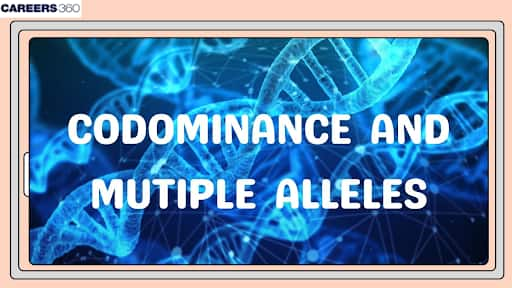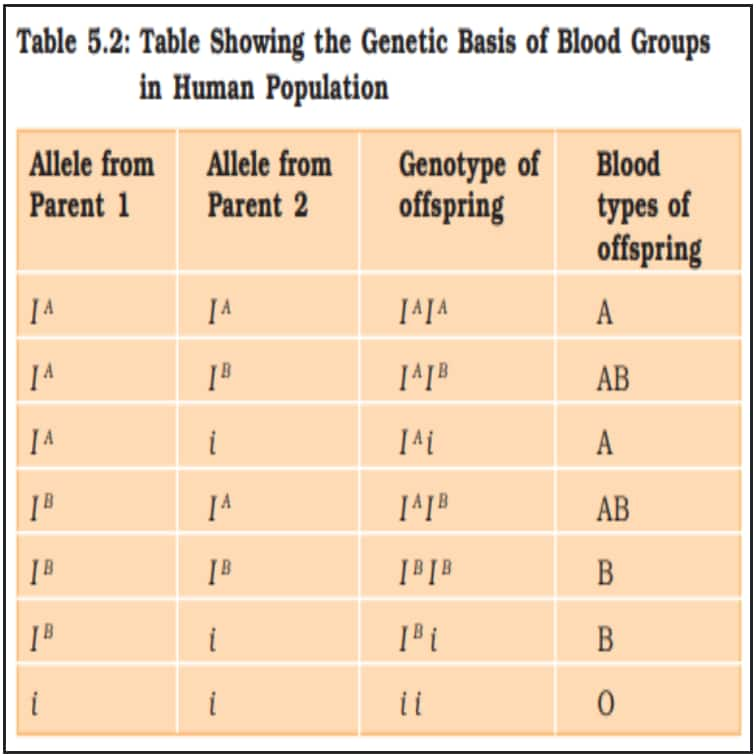Codominance and Multiple Alleles
Codominance and multiple alleles are important genetic concepts that help explain the diversity seen in inherited traits. In codominance, both alleles in a heterozygous individual are fully expressed without blending. This results in phenotype that shows characteristics of both alleles. Multiple alleles refers to the presence of more than two alleles within a population. These principles go beyond the principles of Mendelian Genetics.
This Story also Contains
- What Are Codominance And Multiple Alleles?
- Genetics Basic Concepts
- Codominance
- Multiple Alleles
- Table: Different Combinations of Multiple Alleles
- Recommended video for "Codominance"
- MCQs on Codominance and Multiple Alleles

Understanding codominance and multiple alleles helps in the fields of medicine, agriculture, and forensics. In agriculture, breeders use these patterns to improve crop traits and livestock. In genetic research, these concepts help explain the complex inheritance and support advancements. Studying these concepts allows scientists to understand genetic variability and its effects on health and evolution.
What Are Codominance And Multiple Alleles?
Codominance is expressed when two alleles in a heterozygous condition are not masked. This results in an organism exhibiting both alleles, such as ABO blood grouping where both A and B are seen in an individual.
Multiple alleles mean that for a given locus there may be more than two alleles in the population. This gives rise to variation. These concepts are important in genetics as they highlight more than one character involved. The pattern of inheritance is different from simple dominance and recessive.
Genetics Basic Concepts
To understand codominance and multiple alleles, it is essential to know the basics of genetics. These concepts help to explain how traits are inherited and expressed in organisms. The basic definitions are given below:
Alleles And Genes
Genes are segments of the DNA responsible for the determination of certain traits. While alleles are modified forms of genes from the same family that are caused by mutation and occupy the same locus on a chromosome. For example, eye colour in human beings, some alleles code for blue, brown, green, etc.
Dominant And Recessive Alleles
Dominant alleles overpower recessive alleles. The dominant alleles are observable in phenotype whereas recessive alleles do not show in people who possess both the dominant and recessive alleles of that gene. For example in pea plants, the character of yellow seed dominated over green seed which is a recessive character.
Concept of Homozygous And Heterozygous
There are over 400 loci in humans. Homozygous individuals possess two similar alleles at a particular locus BB for brown eyes and heterozygous individuals possess two dissimilar alleles at different locus Bb for brown eyes. This separation determines the expression of traits by Mendel’s laws of inheritance.
Codominance
Codominance hence means a situation in a heterozygous individual where both genes are expressed, not blended and easily seen. Codominance differs from incomplete dominance since the latter involves the blending of traits, while blending does not occur in codominance.
Examples Of Codominance
1. ABO Blood Group System In Humans (ABO System):
The blood groups in humans, ABO blood group system, consists of the following three alleles IA which codes for antigen A, IB which codes for antigen B, and I which codes for the non-production of both the antigens. People with genotype IAIB on their red blood cells codes for A and B antigens are expressed, thus showing codominance.
2. Coat Color In Animals (e.g., Roan Cattle):
Roan cattle’s coat colour means that red and white hair are distributed in equal measures. This is because of the gene interaction for red and white colours.
Multiple Alleles
Multiple alleles mean the occurrence of more than two alleles in a particular gene. Allele is an alternative form of a gene that exists for a specific trait in a population. Nevertheless, within each individual, there are only two alleles each of which is contributed by one of the parents only.
Examples Of Multiple Alleles
1. ABO Blood Group System:
The ABO blood group system comprises three alleles; IA, IB, and i which outlines the presence of antigens in red blood cells. IA and IB are equally dominant and show codominance while i is a recessive factor.
2. Rabbit Coat Color:
The coat colour of rabbits is controlled by multiple alleles. For example, the alleles for brown, black and white coats colours which work in combination, can give an actual coat pattern.
Table: Different Combinations of Multiple Alleles
The ABO blood group system is a classic example of multiple alleles in humans. It is controlled by a single gene (I) with three alleles: IA, IB, and I. Different combinations of these alleles result in four blood types: A, B, AB, and O.
Allele Combination | Phenotypic Expression |
IAIA or IAi | Blood type A (antigen A) |
IBIB or IBi | Blood type B (antigen B) |
IAIB | Blood type AB (antigens A and B) |
ii | Blood type O (no antigens) |
Recommended video for "Codominance"
MCQs on Codominance and Multiple Alleles
Q1. ABO blood grouping show phenotypes and genotypes respectively,
6, 2
6, 4
3, 6
4, 6
Correct Answer: 4) 4, 6
Explanation:
ABO blood grouping shows 4 phenotypes, i.e., Blood group A, blood group B, blood group AB, and blood group O.

There are a total of 6 genotypes for ABO blood grouping. Two genotypes for blood group A, two for blood group B, one for blood group AB, and one for blood group O, and these are a total of 6 genotypes.
Hence, the correct answer is option 4) 4,6
Q2. A mother of blood group O has a group O child. The father could be of blood type
A, B, or O
O only
A or B
AB only
Correct Answer: 1) A, B, or O
Explanation:
If a mother with blood group O (genotype OO) has a child with blood group O, there are several possibilities for the father's blood type. The father could be of blood type O (genotype OO), as both parents passing on an O allele would result in a child with blood group O.
Additionally, the father could also be of blood type A or B, but with certain genotypes. If the father is of blood type A, he could have the genotype AO, where he would pass on either an A or an O allele to the child. If the father is of blood type B, he could have the genotype BO, where he would pass on either a B or an O allele to the child. In both cases, if the father passes on an O allele to the child, the blood group will be O.
It's important to note that blood type inheritance follows Mendelian principles, where A and B alleles are dominant over O alleles. Therefore, if the father were to have blood type AB (genotype AB), the child could not have blood type O since both A and B alleles are dominant over O.
Hence, the correct answer is option 1)A, B, or O
Q3. Multiple alleles are present:
At the same locus of the chromosome
On non-sister chromatids
On different chromosomes
At different loci on the same chromosome
Correct Answer: 1) At the same locus of the chromosomes
Explanation:
In multiple alleles, two or more alternative forms of alleles can occupy the same locus as chromosomes. In multiple alleles, two or more alternative forms of an allele exist at the same genetic locus, allowing for a wider variation in traits. Each individual still inherits two alleles, one from each parent, but the population may have more than two alleles at the same locus. A common example of multiple alleles is the ABO blood group system, where A, B, and O alleles determine blood type.
Hence, the correct answer is option 1 ) At the same locus of the chromosome
Also Read:
Frequently Asked Questions (FAQs)
No, codominance refers to both alleles being expressed equally in a heterozygous condition, while multiple alleles means a gene has more than two possible alleles in a population.
The ABO blood group system is an example where codominance (IA and IB) and multiple alleles (IA, IB, I) are both observed.
Skin color is an example of polygenic inheritance, where multiple genes influence a single trait.
In codominance, both alleles are fully expressed, while in incomplete dominance, the phenotype is a blend of both alleles.
Sickle cell anemia is an example of pleiotropy as a single gene affects multiple traits like red blood cell shape, pain, and organ damage.